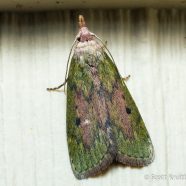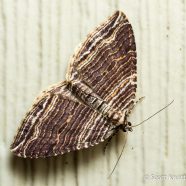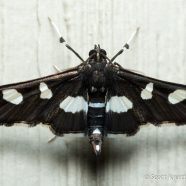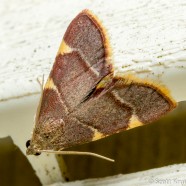The Bee Moth
This pretty moth gave me a tough time trying to pin down an identification, but it looks to be a female Aphomia sociella – The Bee Moth. I was less enthusiastic in learning that Aphomia sociella is a non-native and often pest moth that was likely introduced from Europe via the colonists and bee hives. They often end up destroying those hives from the inside out. Everything has its place, I suppose… Scott Kruitbosch Conservation & Outreach Coordinator
Read MoreMany-lined Carpet Moth
Here is the Many-lined Carpet Moth (Anticlea multiferata) on a recent evening…can’t imagine why they call it that, huh…
Read MoreGrape Leaffolder (Desmia funeralis) Moth
Last year I started looking more at the seemingly endless world of moths, a Roger Tory Peterson tradition and passion when he was a small boy in Jamestown. Day and night, cloudy or clear, cool or hot, forest to shore – there are moths everywhere, and their flight seasons are always changing throughout the spring, summer and fall. I intend to continue to do some mothing this year when I can find a little time here or there. On Friday evening I found several new (to me) and unique moths including this Grape Leaffolder (Desmia funeralis) moth. I will keep doing my best to identify all...
Read MoreJupiter
Last night I put on my porch light and black light to see if any moths were in the air. They were not, yet – some have been already, though the conditions that night were not great for them and the temperature lately was not helpful. A chilly north wind kept migrant birds to a minimum, and I only heard a couple of call notes going over. I saw Jupiter shining brightly in the clearing sky. While Connecticut’s light pollution and my inexperience of shooting the night sky make it a little less pretty and a little more difficult (not to mention the moon since I hadn’t planned...
Read MoreClover Hayworm Moth
Here’s what seems to be the Clover Hayworm (Hypsopygia costalis) moth, a species that I saw on multiple occasions during the middle of the summer. Apparently their name is derived from their caterpillars being a historic pest in haystacks, and they feed on various forms of dried vegetation. Scott Kruitbosch Conservation & Outreach Coordinator
Read More








